The Intel Optane SSD 900P 280GB Review
by Billy Tallis on October 27, 2017 9:30 AM ESTAnandTech Storage Bench - Heavy
Our Heavy storage benchmark is proportionally more write-heavy than The Destroyer, but much shorter overall. The total writes in the Heavy test aren't enough to fill the drive, so performance never drops down to steady state. This test is far more representative of a power user's day to day usage, and is heavily influenced by the drive's peak performance. The Heavy workload test details can be found here. This test is run twice, once on a freshly erased drive and once after filling the drive with sequential writes.
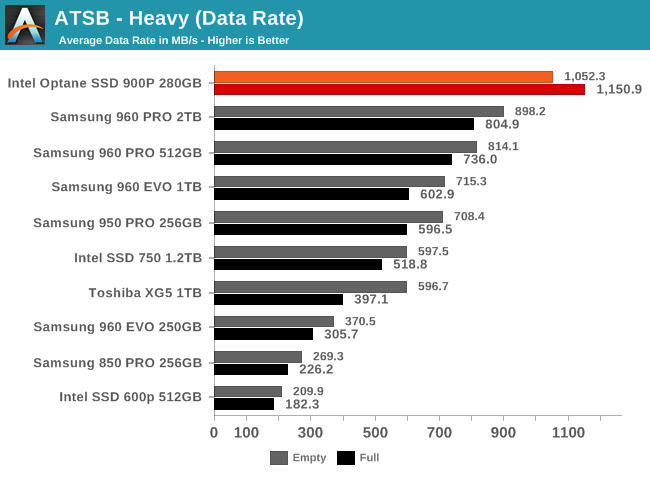
The Intel Optane SSD 900P completes the Heavy test with a higher average data rate than any flash-based SSD. Curiously, it performs even better after being filled than it does right after a low-level format. Even the best flash-based SSDs lose a bit of performance when operating with minimal spare area. The Optane SSD by contrast seems to require an extra initialization phase after the format to reach full performance.
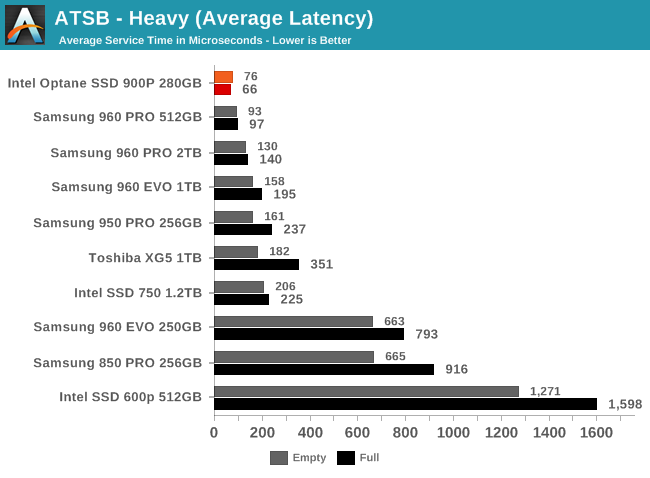
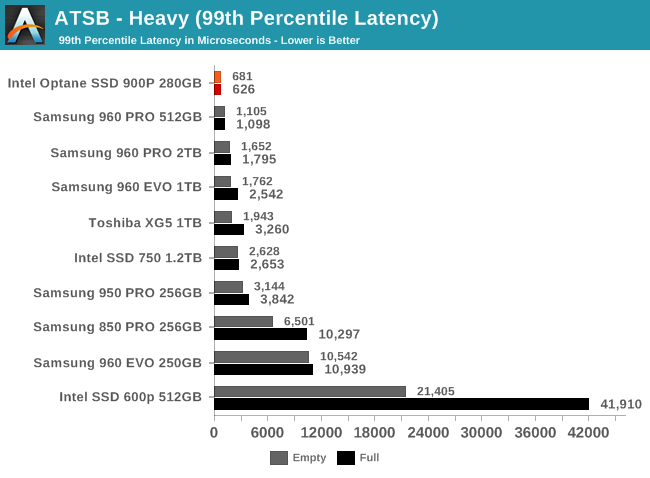
As with The Destroyer, the Optane SSD sets records for both average and 99th percentile latency on the Heavy test. The margin for the 99th percentile latency is more significant, with about a 43% improvement over the previous record.
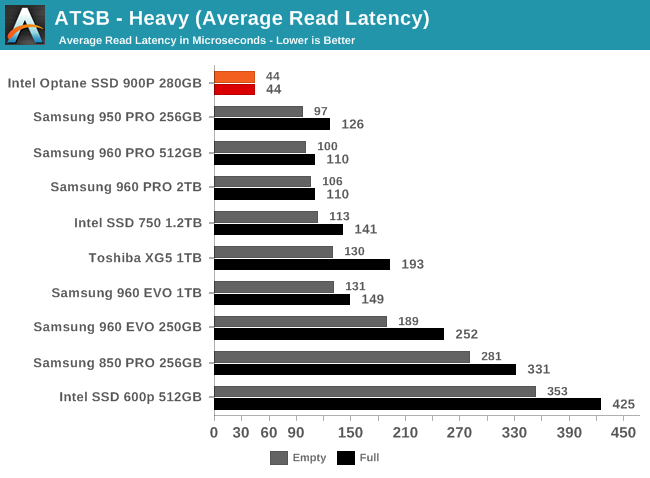
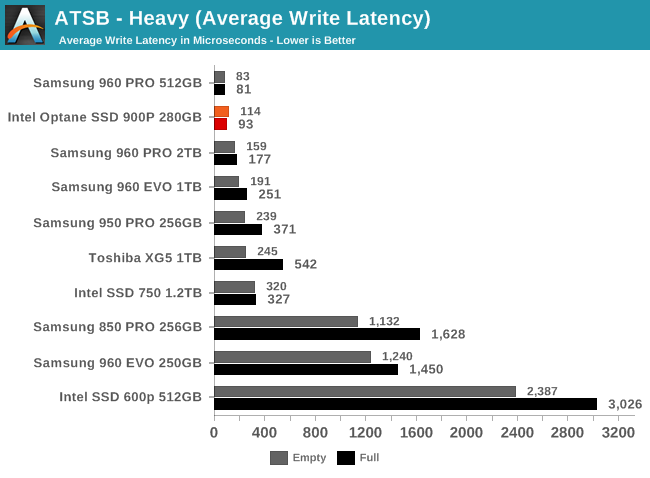
The average write latency of the Optane SSD 900P on the Heavy test comes in as a close second place, while the average read latency sets a new record that is less than half the previous best score.
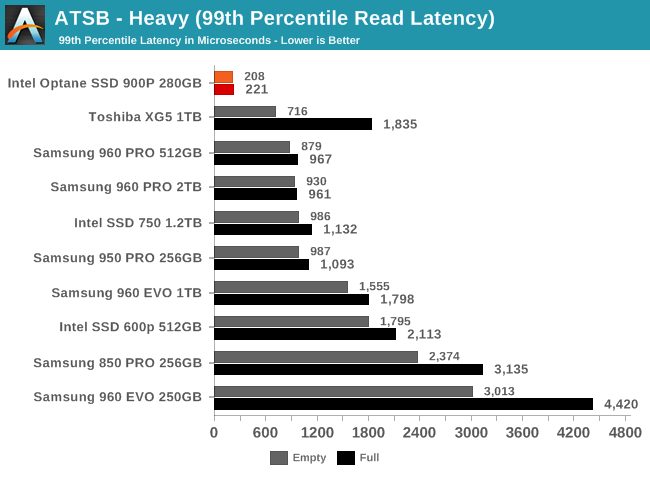
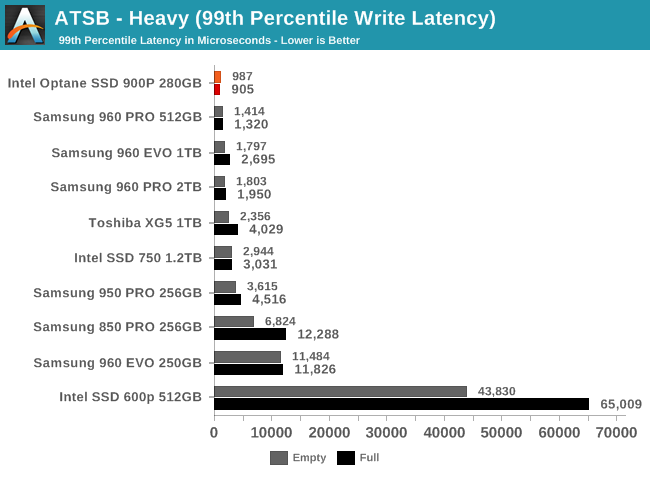
The Optane SSD's new record for 99th percentile read latency on the Heavy test is 70% lower than the fastest flash-based SSD. The record for 99th percentile write latency is a less impressive 30% improvement over the previous record.










205 Comments
View All Comments
Kevin G - Monday, October 30, 2017 - link
The software side does lag behind hardware by a substantial amount of time. However, the ground work is already being done. The first initial wave of support will be mundane as a 'RAM disk' but with firmware/hypervisor/OS support so that only Optane DIMMs are utilized for this functionality. Software overhead would still exist for the file system but legacy support would be maintained. I think patches already exist for this level of functionality in Linux, though I'm unsure if they're been rolled into the mainstream kernel.Kevin G - Monday, October 30, 2017 - link
Intel still has this potential on their road maps for 2018 with the Cascade Lake Xeons. Supporting Optane as memory requires some changes in the memory controllers and Intel is only targeting their Xeon lineup with such support. This was initially to arrive with Sky Lake-EP but was cut at the last minute due to apparently some bugs found in testing. This is what there are a few Sky Lake-EP motherboards out there with an extra memory slot that can't be used: it was only for the unreleased Optane DIMMs.The other thing is that Optane DIMMs were NEVER hyped to be faster than commodity DRAM. Intel never set that expectation and from all accounts, Optane is genuinely slower. However, byte addressability is there as is a strong increase in endurance for it to function in such a role, if slower. Any sort of performance gains will stems form various ideas that you mention, like the removal of a traditional storage stack etc.
The other side of storage is capacity which Intel has really yet to demonstrate. Their talk of Optane DIMMs were to hit 1 TB per DIMM eventually but the sizes here point toward capacities in DIMM format roughly the same as traditional DIMMs (128 GB right now in servers with 256 GB on the horizon). I know of a few big data guys that dream of a system that could easily support 96 TB (1 TB DIMM per slot, 12 DIMM slots per socket, 8 sockets total) that would permit their entire cluster to be run on a single node and in-memory. At this point having the Optane DIMMs being slower than DRAM wouldn't matter as it would eliminate traditional bulk storage and networking overhead which are slower still. The potential is huge at the highend if Intel can get the technology out in the right form factor and at the capacities they need.
Only reason Intel is launching like this now is that they need to get the technology out there and ramp up production. If it weren't for the Sky Lake bug, they would have launched the DIMM format by now.
4shrovetide - Sunday, October 29, 2017 - link
If someone picks up one of these and doesn't play games or just doesn't want the Star Citizen code, would you mind sending it to me? 4shrovetide@gmail.com Thank you in advance to anyone who helps out!AnnonymousCoward - Sunday, October 29, 2017 - link
What a copycat name, 900P! Like 950 Pro.Kevin G - Sunday, October 29, 2017 - link
I'm disappointed over all.The latency advantage is genuinely there as is random performance (which latency is factor in itself) but sequential performance falls short of the hype. What is disappointing as well is that only the 280 GB drive is going to be offered in U.2 format and capacities top out at 480 GB even of the add-in card model. The real ugly factor is power consumption which to Intel's credit wasn't hyping up prior to launch is high relative to other SSD solutions.
The biggest promise of 3D Xpoint/Optane is in DIMM form factor with byte addressability. Intel delayed that last minute with Sky Lake-EP and told people to expect that with Cannon Lake-EP. It looks like Cannon Lake-EP is being delayed due 10 nm issues into 2019 so we're getting a 2018 refresh of Sky Lake-EP called Cascade Lake with the missing Optane DIMM support back-in. The hype of Optane was that while radically slower than DRAM, you do get nonvolatile support and a massive capacity increase, everything else being equal. The performance equation does change as operating system and applications are adapted to an all in-memory centric view (i.e. the concept of long term disk storage is removed, everything is seen as 'in-memory'). It isn't that Optane magically becomes faster but simply that a chunk of software necessary to work in today's view of fast volatile memory and slow persistent memory is no longer needed. It is simply an opportunity to gain in algorithmic efficiency by not having a traditional storage stack. This effect can be seen again if Optane DIMM sizes are well beyond that of DDR4 DIMMs and used in conjunction with large socket (think 8 or more) that could replace some clustered workloads and removing the networking stack from the performance equation.
The really big disappointment is this launch doesn't point toward living up to the remaining hype at all. The lack luster capacity today certainly implies that the DIMM sizes necessary to threaten DRAM may not happen. 128 GB registered ECC DDR4 LR-DIMMs are out there today and 256 GB models are on the horizon. From the looks of it, Optane could make the 256 GB capacities in DIMM form and certainly come in cheaper but that wouldn't be as large of a game changer. Sure, the software changes for a pure in-memory system could still happen but it wouldn't enable any new workload that couldn't be done via current software and memory capacities. Tried and proven will win out even if it is more expensive because it is known quantity that works.
"Bullwinkle J Moose" - Monday, October 30, 2017 - link
Any thoughts on Advanced Persistent Threats that will be lingering around when 3D Xpoint/Optane is in DIMM form factor ?Seems no-one has yet been willing to address the issue
I would never consider persistent memory for just that reason alone
And, swapping boot drives or restoring backups won't help it seems
Any comments on the issue?
Kevin G - Monday, October 30, 2017 - link
While a threat may persist in non-volatile memory, it still needs to be executed which is invoked from the host system. Cleansing an Optane DIMM maybe as simple as putting it into a system that is programmed to immediate wipe said Optane DIMM. There will always need to be a means to do some initial configuration/initialization which would be embedded at the firmwire level. In other words, the DIMMs don't have to be running an OS for them to be securely erased.Similarly, moving a DIMM from one system to another system is also possible, though the default should actually be to do nothing by default. As weird as it is, there exists the possibility of moving a running application from system to system by this method. This goes to your point about security. Thus the default for any system capable of hot swap or detecting a newly installed DIMM after power cycle, should not actually access the contents of that DIMM until given instructions to access it.
"Bullwinkle J Moose" - Monday, October 30, 2017 - link
But wiping the DIMM defeats its very purpose for existing..............PERSISTENCE!Kaspersky found out how bad malware can be when it only runs in system memory and never touches a disk, networking the infected systems added persistence to the threat
If you need to wipe the DIMM or disconnect from any networked machines, you eliminate any tiny perceived benefit this technology "could" give you over the tech we already have
I say "Tiny" benefit only as it relates to the "massive" threat it can create from being persistent
regis440 - Monday, October 30, 2017 - link
Faster then SDRAM PC133. Sign of the time :)jrs77 - Monday, October 30, 2017 - link
General purpose storage starts at a very minimum of 1TB these days. 2TB would be more appropiate with the ever growing filesizes of high resolution video and image-files.480GB is filled up with a handfull of game-installations allready these days. So these SSDs are only usable as OS/software disks and for that the price is way too high.
Call me again when SSD-prices drop to ~ $100 / TB. Then we're talking usability as general storage drives.